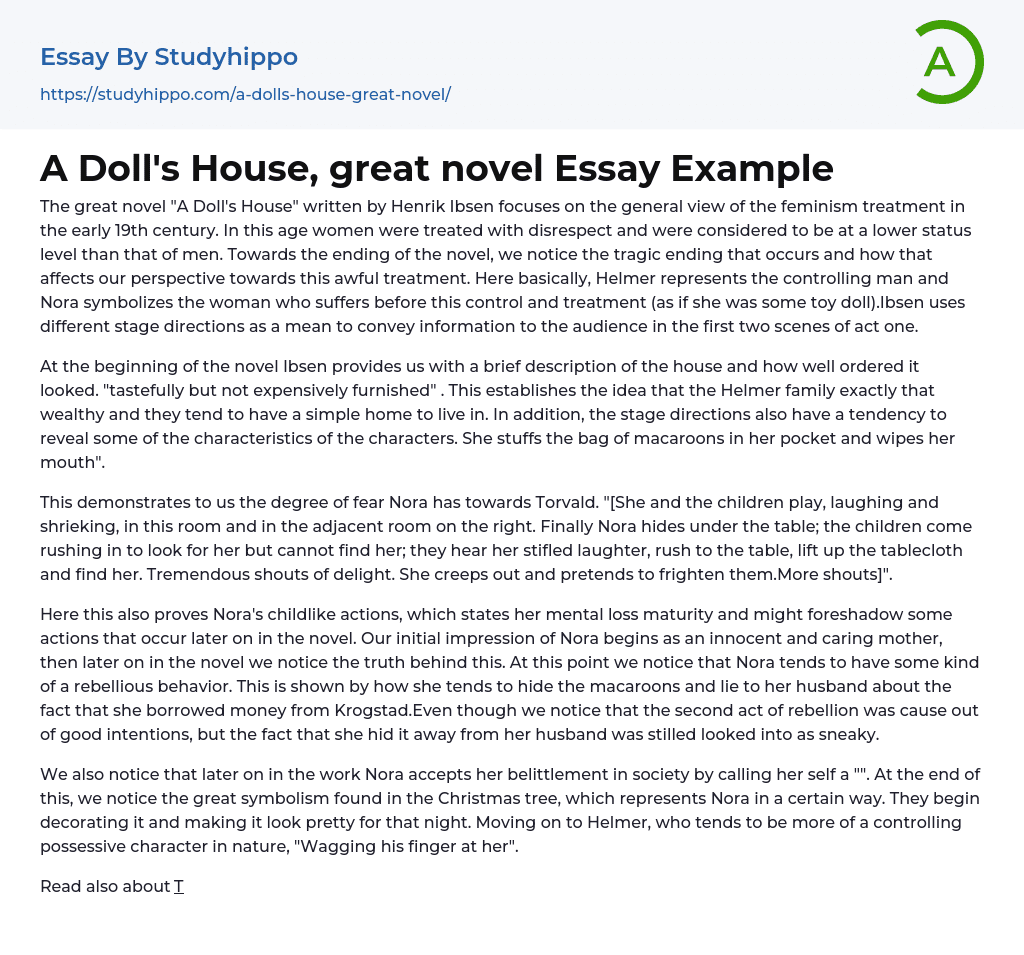The focus of Henrik Ibsen's novel "A Doll's House" is the treatment of feminism during the early 19th century, where women were treated with disrespect and deemed inferior to men. The tragic ending of the novel prompts a shift in perspective towards this treatment, as Helmer represents the controlling man and Nora symbolizes the woman who suffers before this control and treatment, akin to a toy doll. To convey information to the audience in the first two scenes of act one, Ibsen utilizes different stage directions.
At the start of the book, Ibsen briefly portrays the orderly appearance of the house, which is "tastefully but not expensively furnished". By doing so, he establishes that the Helmer family is not very wealthy and they reside in an unadorned residence. The directions on stage al
...so have a tendency to reveal the traits of the characters, such as when "she stuffs a bag of macaroons in her pocket and wipes her mouth."
The extent of Nora's fear towards Torvald is shown through her behavior. Nora plays with her children in the nearby rooms, laughing and shrieking. At one point, she hides under the table and her children search for her, unable to find her. As they hear her muffled laughter, they rush to the table and lift the cloth to discover her. There are great shouts of joy as she emerges and pretends to frighten them.
The behavior of Nora in the novel shows her childlike nature and hints at her actions later on. Initially, she appears as a caring and innocent mother but as the story progresses, we see her true nature. Her rebellious behavior is evident fro
how she hides macaroons and lies about borrowing money from Krogstad. Although her second act of rebellion was well-intentioned, concealing it from her husband was seen as deceitful.
It is observed that Nora acknowledges her inferior status in society by referring to herself as a "". The Christmas tree is also a significant symbol that represents Nora. As they adorn it to make it beautiful for the night, Helmer, who is typically controlling and possessive, admonishes Nora by wagging his finger at her.
Check out The Doll's House by Katherine Mansfield. In addition, Nora's husband, Torvald, restricts her from owning certain items, which prompts her to behave rebelliously. "Rank: Look at this, eh? Macaroons. I thought they were forbidden here, Nora. Torvald had forbidden them."
Torvald's preoccupation with his work and lack of interest in socializing is evident from the start of the novel. Furthermore, he expresses concern over potential harm to his wife's teeth. These aspects offer insight into Torvald's character. The dynamic between the husband and wife is a prevalent theme throughout the story.
Throughout the play, Ibsen creates an atmosphere using dialogues and stage directions. The dominant component of the couple tends to be the husband, who overrules his wife's desires and forces her to follow his regulations wherever she goes. However, despite this dynamic, Nora proves her love for Torvald by successfully saving his life. Torvald still has yet to prove himself in the work.
The length of sentences and punctuation at the end create a certain mood for the audience, as does movement and stage directions. Nora's actions of tidying up and playing with Torvald's shirt while she "smiles and hums" gives a
calm, romantic and mysterious atmosphere. On the other hand, her actions of being "tense, taking a step towards him and speaking in a low voice" creates a different type of atmosphere. Ibsen's description of Helmer's actions such as "looking through his papers" and "coming in by the hall door with a bundle of documents under his arm" gives a better understanding of Helmer's character and reveals the atmosphere. These stage directions contribute greatly to creating a wider and clearer understanding of the play's atmosphere.
To sum up, Henrik Ibsen skillfully employs techniques to develop characters and build an engaging atmosphere in the play. The audience is kept engaged and curious about the ending as the play progresses. As noted by Harley Granville-Barker, it was considered the most dramatic event of the decade, and according to William Archer, it had garnered extensive comment and analysis in newspapers, making Ibsen a famous figure in English literary circles. Although some expressed hostility towards the play, there were also influential supporters who polarized into 'Ibsenist' and 'Anti-Ibsenist'. Overall, it presents many relatable points from past and present life, making it a fantastic read.
- Cleaning essays
- A Doll's House essays
- A Midsummer Night's Dream essays
- A raisin in the sun essays
- A Streetcar Named Desire essays
- An Inspector Calls essays
- Death of a salesman essays
- Everyman essays
- Fences essays
- Hamlet essays
- Hedda Gabler essays
- Iago essays
- King Lear essays
- Macbeth essays
- Much ado about nothing essays
- Oedipus Rex essays
- Oedipus The King essays
- Othello essays
- Pygmalion essays
- Romeo And Juliet essays
- Tartuffe essays
- The glass menagerie essays
- The Importance of Being Earnest essays
- The Merchant Of Venice essays
- The Taming of The Shrew essays
- Twelfth Night essays
- Waiting For Godot essays
- Adaptation essays
- Adventure essays
- Adversity essays
- Aging essays
- Alcohol essays
- Barbie Doll essays
- Beauty essays
- Care essays
- Carpe diem essays
- Change essays
- Chess essays
- Chicken essays
- Choices essays
- Contrast essays
- Crops essays
- Development essays
- Dream essays
- Evil essays
- Experience essays
- Family essays
- Farm essays
- Fire essays
- First Love essays




